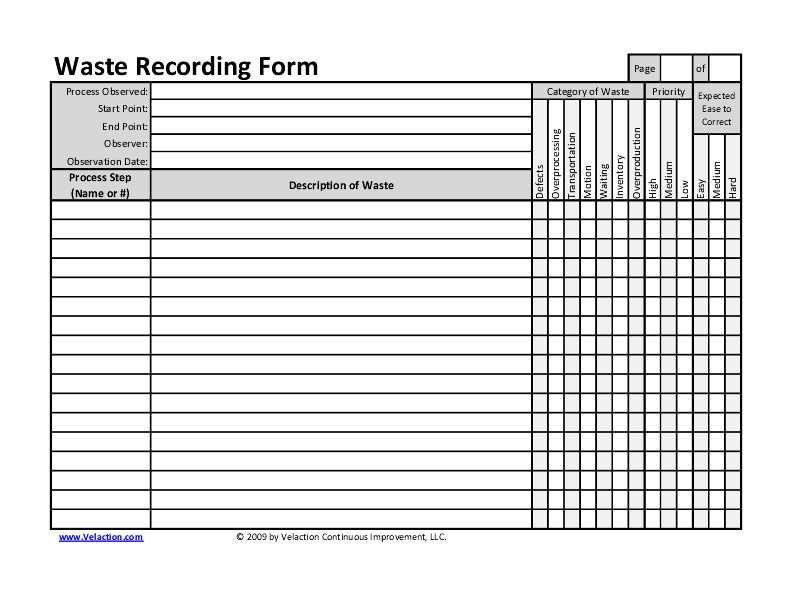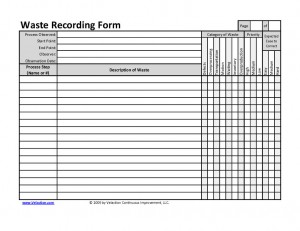Motion Waste
The waste of motion is one of the seven wastes attributed to Taiichi Ohno, the father of modern Lean.
Motion is, simply put, moving more than necessary when doing work. It can be large motions, such as walking between work areas, or small motions, such as flipping a screwdriver over after pulling it from a shadow board.

Click the image to download a free Waste Recording Form.
Motion waste also occurs in office environments. Walking to printers and fax machines, excessive clicking, or searching for supplies in a messy cabinet are all examples of wasted motion.

Big wastes of motion are easily recognizable and are often eliminated through common sense. But there is a limit to an individual’s ability to remove this waste on his or her own. When the layout of a work area is excessively large, often as a byproduct of overproduction, distances increase, leading to more wasted motion.
Small motion waste, though, is far more within the control of a person. It is also generally harder to recognize as waste, as there is an assumption that motion is just part of the job.
For clarification, I view a person walking as “big” motion and hand motions as “small.” Carrying parts or tools between locations is transportation waste. Simply moving empty handed to do something is motion waste.
How many of these motions do you recognize from your workspace?
- Pulling a tool from its storage space and flipping it to orient it for use.
- Sifting through a toolbox for the right size wrench, or through a stack of files for the right folder.
- Clicking through a long series of folders on a computer.
- Walking to a community printer or fax machine.
- Reaching across a workbench to get the right part.
- Shuffling through a pile of materials to get the right component for the current production item.
- Picking up an item that was dropped on the floor.
Each of these wastes are common in workplaces, but also have a tendency to be overlooked as a problem.
Small motion waste, though, adds up. And it adds up faster in high volume work areas. But even in areas with long cycle times, small motion waste has an impact. The impact, though, is often in the form of future improvements. When a person reduces a reach or a tool twist that they do only a few times a day, the annual savings might just be a handful of minutes. The time invested in making small gains is often bigger than the savings over the next year or two. But focusing on these small motions raises awareness of the waste. And as new processes are developed, they are put in place with more of a focus on keeping waste out. That is where the substantial gains often come from.
Getting Rid of Motion Waste
Large motion waste—typically walking in large work areas, is often removed by limiting overproduction, which reduces the number of parts to walk past, and by creating product-oriented work area, which reduces walking between stations.
Small motion waste is generally removed by implementing good 5S practices. Searching, reaching, and reorienting are all diminished when a work area is organized for effective production.
Some strategies to remove motion waste include:
- Store tools so they are oriented for immediate use. (i.e. have the handles of screwdrivers stick out instead of sitting flush against a shadow board.
- Place the most frequently used tools and parts closest to the work area.
- Limit big workbenches. Use small, right-sized benches instead.
- Deliver items to internal customers as they want them.
- Make fixtures simple to use. Think clamps instead of screws.

Words of Warning:
- Don’t think short term when looking at the cost-benefit of reducing a small motion. The shift in mindset will make a big long-term impact if you attack all waste.
- Don’t let big obstacles create motion waste. Look at the underlying issue (i.e. overproduction or process-oriented work areas) that create waste.
- Small motion waste can have an ergonomic impact in the form of repetitive stress injuries.
- Bigger motion waste can cause injuries through bending and reaching.
- Don’t look for your own waste. Get a coworker to observe you so you don’t overlook the things you have become numb to.

Motion waste can seem very necessary. As a result, it is easy to be accepting of it. Try not to become complacent. When you get a bit of downtime due to line stops or parts shortages, try to go after the little wastes that bug you.
Motion waste is not as big of a frustration as defect waste, but it has a cumulative effect on your job satisfaction. It is often fatiguing, and makes your job take more out of you than it should. In most Lean jobs, you will be moving pretty consistently all day. But motion waste, because it is unnatural, can take more energy out of you than a well-designed, productive activity.

Provide your team with the tools to remove the small motion wastes from their job. This sort of improvement provides you with a great way to build a continuous improvement culture. People can rearrange tools on their own or do simple 5S tasks. Stressing these sorts of improvement efforts does two main things.
- It sends the message that making improvements, no matter how small, is important. This shift in mindset is the foundation for improvement.
- It provides a training Motion waste reduction can be low-risk, and relatively simple. It is a good chance for frontline employees to…
Extended Content for this Section is available at academy.Velaction.com

Key Points About Motion Waste:
- Motion waste looks like value added work in many cases.
- Small motion waste adds up.
- Reducing motion waste is a gateway to bigger improvement projects.
![]()
Exclusive Content for this Section is available at academy.Velaction.com
![]()



0 Comments